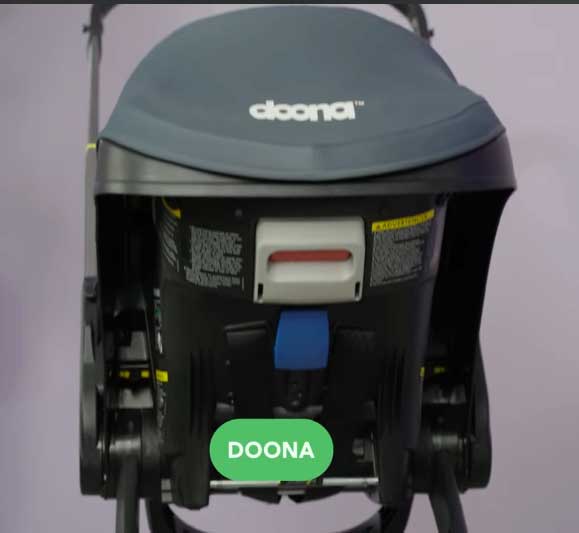As a new parent, I was obsessed with finding “the one” piece of baby gear that would make life simpler. I quickly zeroed in on the all-in-one car seat stroller, a category dominated by the famous Doona. Then, its first true competitor, the Evenflo Shyft DualRide, hit the market.1 I’ve spent countless hours analyzing both, and the choice isn’t as simple as you’d think. My goal here is to give you the real-world breakdown I wish I had, helping you decide which of these innovative systems is truly the better investment for your family.
A Brief Comparison Table
| Feature | Doona | Evenflo Shyft DualRide |
| Price | ~$550 | ~$550 |
| Product Weight (As Stroller) | ~16.5 lbs | ~19 lbs |
| Product Weight (Carrier Only) | 16.5 lbs (Wheels are integrated) | ~9 lbs (Wheels are detachable) |
| Child Weight Limit | 4-35 lbs | 3-30 lbs |
| Child Height Limit | Up to 32″ | Up to 32″ |
| Base Included? | Yes, LATCH Base | Yes, Anti-Rebound Bar Base |
| Harness Type | 5-Point Rethread | 5-Point No-Rethread |
| Storage Included? | No | Yes (Carry-all bag & cupholder) |
| Smart Tech | No | Yes (SensorSafe Chest Clip) |
| FAA Approved | Yes | Yes (As carrier, without base) |
My Experience With The Doona
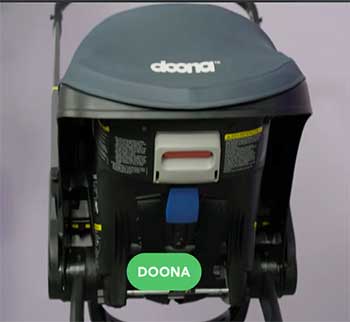
My relationship with the Doona was a classic love-hate story.
For the first four months, I was a walking advertisement for it. I felt so smart.
While other parents fumbled with unfolding strollers in the doctor’s office parking lot, I was already inside.
I’d pop the wheels, roll my sleeping baby in, and feel like a superhero.
It was amazing for those tiny, in-and-out errands that dominate newborn life.
Then, the “hate” part started to creep in. It began with the weight. Lifting 16.5 pounds plus my 12-pound son out of the car and lining it up with the base was jarring. I could feel the strain in my back. Then, I went to the farmers market. I bought a small bag of apples and… had to carry them. I had my coffee in one hand and the apples in the other, all while trying to push the stroller. I felt ridiculous.
The final straw was our first “long walk” around the neighborhood. The sidewalks in my area are not perfect. The tiny, hard wheels of the Doona translated every single crack and bump directly to my son. His head was bobbling, and he woke up fussy. I realized the Doona wasn’t a stroller at all. It was a car seat that could roll on smooth floors. By the time my son was 11 months old, his head was nearly at the top, and his legs were bunched up. I sold it and felt a strange mix of relief and disappointment. It was a brilliant, one-trick pony, but the trick got old fast.
Pros Of The Doona
- The Original Seamless Transition: This is the Doona’s entire identity.2 The mechanism to deploy and retract the wheels is incredibly smooth, polished, and truly a one-handed operation after you’ve done it twice. When I say seamless, I mean it. I could get out of the car, unlatch the seat from the base, set it on the ground, press the lever, and have a stroller ready to go before my car door was even closed. This seamlessness is its primary advantage; it feels like a premium, well-engineered product. For quick trips, like running into the daycare for pickup or grabbing a coffee, this feature is undefeated. It eliminates the “is it worth bringing the stroller?” debate entirely. You don’t have to open a trunk, wrestle a frame, or click anything into place. The wheels are just there.
- Lighter All-In-One Unit: When you compare the two systems in their “stroller mode,” the Doona is noticeably lighter, weighing around 16.5 pounds. The Evenflo Shyft, with its wheels attached, clocks in closer to 19 pounds.3 While 2.5 pounds might not sound like much, you feel it when you’re also lifting a 15-pound baby. This lighter weight makes the entire unit slightly easier to maneuver, pop over a curb, or navigate through a tight clothing store aisle. It’s a single, cohesive unit, and its relative lightness in this form is a clear benefit for anyone who might be recovering from birth or has to frequently lift the entire system.
- Proven Track Record and Travel-Friendly: The Doona has been on the market for years, creating a huge ecosystem of accessories (sold separately, of course) and a proven track record. It’s also FAA approved for air travel.4 I found the idea of wheeling my baby right up to the gate, folding the Doona into its car seat mode, and strapping it into the airplane seat to be incredibly appealing. It simplifies the airport equation dramatically. Because the wheels are permanently attached, you cannot lose them, and you are never without your stroller. For families who fly often or rely heavily on rideshares, this simplicity is a massive selling point that has been tested by thousands of parents.
- Sleek, Compact Footprint: There’s no denying the Doona has a certain aesthetic. It’s sleek, compact, and looks futuristic. When in stroller mode, its footprint is tiny. I loved this for navigating crowded restaurants or small city apartments. It doesn’t feel like you’re driving a massive pram; it feels like a car seat on wheels, which is exactly what it is. The handle also functions as the anti-rebound bar when installed in the car, which is a clever, space-saving piece of design.5 This minimalist approach appeals to parents who don’t want to feel overwhelmed by bulky gear and value a compact, efficient design that fits easily into small spaces.
Read more: My Thoughts on CCIYU Auto Parts
Cons Of The Doona
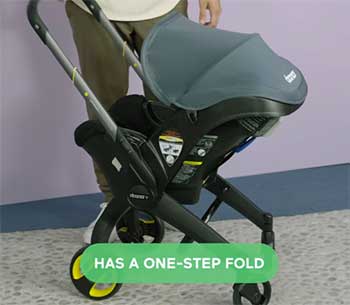
- It Is Heavy, Full Stop: This is the complaint I heard most, and it’s the one I experienced firsthand. Yes, 16.5 pounds is light for a stroller, but it is incredibly heavy for an infant car seat.6 Every single time you put it in the car or take it out, you are lifting that entire 16.5-pound unit, plus the weight of your growing child. When my baby hit 15 pounds, I was lifting over 31 pounds at an awkward angle into my SUV. It was a back-breaker. This isn’t a “sometimes” problem; it’s an “every single time you use the car” problem. If you have a C-section or any back issues, this weight is a serious, daily drawback that cannot be ignored.
- Zero Storage. No, Really, Zero: When I say no storage, I mean not even a place to put your keys. The Doona has no basket. You can’t hang a diaper bag on the handle (it’s a tipping risk). You have to buy their specific “Essentials” bag or “Snap-on Storage” just to carry a diaper and some wipes. This was infuriating to me. A simple trip to the grocery store for a “few things” became impossible. Where do you put the milk? Where does your wallet go? This lack of utility makes it a poor choice as a primary stroller. It’s a car seat for quick errands, not a stroller for a day out.
- Extremely Short Lifespan: This is the financial killer. The Doona is expensive, costing as much as a high-end convertible car seat or a full-size travel system. Yet, most babies outgrow it by height or weight well before their first birthday (many by 9-10 months). The 32-inch height limit is the real issue. My baby was long, and he was cramped by 10 months. You are paying a massive premium for about 10-12 months of convenience. After that, you still have to buy a convertible car seat and a separate stroller. It feels less like a purchase and more like a very expensive short-term rental.
- Poor Performance on Rough Terrain: The wheels are small and hard. They are designed for smooth surfaces: malls, airports, doctor’s offices, and smooth sidewalks.7 The moment I hit a broken pavement, gravel path, or even slightly uneven grass, the ride became jarring and shaky. It is absolutely not an all-terrain stroller. This limits its use significantly. If you live in an area with charming cobblestone streets or old, bumpy sidewalks, the Doona will be a shaky, frustrating experience for both you and your baby. It really pigeonholes it as an “urban smooth-surface” device.
My Experience With The Evenflo Shyft Dualride
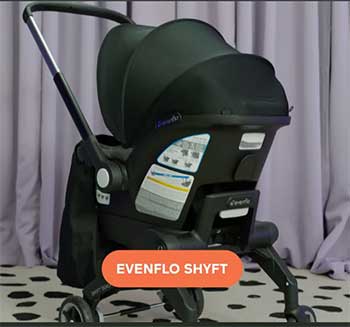
I didn’t personally own the Shyft, but my sister-in-law got one after I complained so much about my Doona, so I got to test-drive it extensively.
The first thing I noticed was the SensorSafe clip. As an anxious person, this feature alone was almost worth the price.
The real-time alerts on her phone were a level of reassurance I didn’t have.
But the feature that made me truly jealous was the detachable carrier.
We went to dinner at my parents’ house, and instead of lugging the entire 19-pound stroller unit inside, she just clicked a button, left the wheel frame in the trunk, and carried in the 9-pound carrier. My jaw dropped. That was it. That was the feature I had desperately needed. It solved the back-breaking lift. It solved the problem of what to do when you don’t need a stroller.
It wasn’t perfect. It felt bulkier than my Doona, and the wheel deployment was definitely more “ka-chunk” than “swoosh.” In her smaller hatchback, it was a very tight fit in the back seat. But the trade-offs were, in my opinion, 100% worth it. It came with a cupholder. It had a little storage bag. The no-rethread harness meant she never had to do the annoying strap adjustment I did. It felt like Evenflo had taken a list of every complaint Doona users had and just… fixed them. It might be a slightly less “premium” feeling mechanism, but it’s an infinitely more practical and thoughtful system.
Pros Of The Evenflo Shyft Dualride
- The Detachable Carrier: This is the Shyft’s killer feature and the single biggest advantage it has over the Doona. You can detach the car seat carrier (which weighs only ~9 pounds) from the stroller wheel frame.8 This completely solves the Doona’s biggest flaw. When I was just running into a friend’s house or didn’t need the stroller, I could leave the bulky 10-pound wheel frame in the car and just carry the lightweight seat. This is a massive quality-of-life improvement. It gives you choices. You can have the full stroller, or you can have a traditional, lightweight infant carrier. The Doona is always the 16.5-pound heavy unit.9 This flexibility makes the Shyft infinitely more practical for everyday use.
- Superior Base and Harness: Evenflo didn’t just copy the Doona; they improved the car seat fundamentals. The Shyft comes with a proper anti-rebound bar on its base, which is a significant safety feature that helps reduce rebound in a crash.10 The Doona’s handle acts as an anti-rebound bar, but many safety experts prefer a dedicated bar on the base.11 Furthermore, the Shyft has a no-rethread harness.12 This means as your baby grows, you just pull a lever to adjust the headrest and shoulder strap height. With the Doona, you have to manually unthread the straps from the back of the seat and re-thread them through a higher slot. It’s a pain, and the Shyft makes it effortless.
- Built-In Tech and Accessories: The Shyft comes out of the box feeling like a complete package. It includes Evenflo’s SensorSafe chest clip, which syncs with your phone and alerts you if the baby is left in the car, if the clip becomes unbuckled, or if the temperature is unsafe.13 For a sleep-deprived new parent, this is an incredible peace-of-mind feature. It also comes with a parent cupholder and a carry-all storage bag that attaches to the side.14 The fact that I didn’t have to spend an extra $80 on accessories just to carry a bottle and a diaper made the Shyft feel like a much better value, even at the same price point.
- Excellent Fit for Small Babies: The Shyft is rated to fit babies starting from just 3 pounds, and its infant insert is known to provide an excellent, snug fit for preemies and small newborns.15 The Doona starts at 4 pounds.16 While a 1-pound difference seems small, for parents of a 3.5-pound preemie, it’s the difference between being able to use the seat and not. The no-rethread harness also makes it easier to get a proper, safe fit on a tiny baby right from day one. This focus on the smallest infants gives it a clear edge for families expecting a smaller-than-average baby.
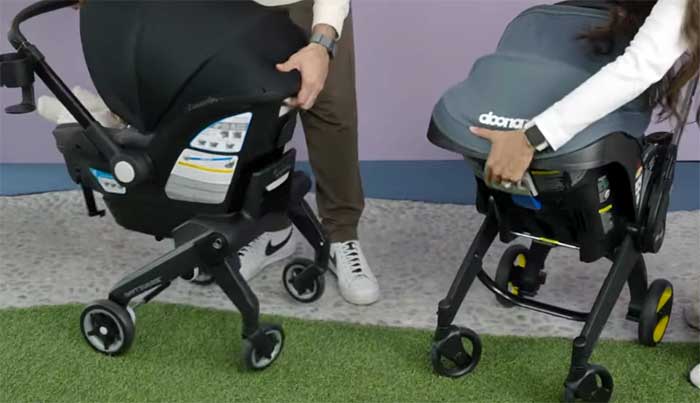
Cons Of The Evenflo Shyft Dualride
- Heavier as a Complete Unit: While the detachable carrier is a brilliant move, the fact remains that when the Shyft is fully assembled in its stroller mode, it weighs more than the Doona (around 19 lbs vs. 16.5 lbs).17 You feel this extra weight when pushing it and especially when lifting the entire assembly. The Doona feels a bit more nimble and streamlined as a stroller. If your primary use case is never separating the carrier and always lifting the whole thing in and out of the car, the Doona is actually the lighter option for that specific task.
- The Transition Isn’t as Smooth: The mechanism to deploy and retract the wheels on the Shyft just isn’t as buttery-smooth as the Doona’s. It works, but it can feel a bit more mechanical or “clunky.” I found it sometimes required a little more jiggling or a more deliberate motion to get it to click into place. The Doona’s mechanism feels like a polished Apple product, while the Shyft’s feels more like a first-generation (though very functional) device. This is a small complaint, but when you’re doing this motion 10 times a day, the “feel” of it starts to matter.
- Takes Up More Space in the Car: The Shyft, particularly when installed on its base, is known to be quite long front-to-back.18 It takes up a significant amount of space in the back seat. In my mid-size sedan, the front passenger seat had to be moved up to a point where it was slightly uncomfortable for a taller passenger. The Doona is also not small, but the Shyft is generally considered the bulkier of the two when installed. This is a critical factor for anyone with a compact car.
- Confusing Manual Storage: This is a very specific but annoying design flaw. The user manual for the Shyft is designed to be stored on the car seat base. This makes sense if you always use the base. But the entire point of a hybrid stroller is for travel and baseless installs in taxis or Ubers! When you are at the airport without your base, your manual—which has the FAA approval info and baseless install instructions—is at home in your car. The Doona stores its manual on the car seat itself. This feels like a huge oversight by Evenflo for the exact use-case they are marketing to.
Maintenance Tips For The Doona
- Washing The Fabrics: The main seat pad, infant insert, and shoulder pads are all machine washable, which is a lifesaver after a blowout.19 My rule was to always use a delicate cycle with cold water and a very mild, baby-safe detergent. Never use bleach. To dry, always hang it to air dry. Putting these covers in a machine dryer can shrink them or, worse, damage the foam padding and safety labels attached to them. It’s best to wash them in the evening so they have all night to dry.
- Cleaning The Hard Shell: The plastic shell, the handle, and the base get surprisingly grimy with spills, dust, and crumbs. My go-to method was a simple bowl of warm water with a few drops of dish soap. Use a soft cloth or sponge to wipe everything down. For the harness straps, you should spot-clean only. Never submerge or machine-wash the harness straps, as this can weaken the fibers. Just use a damp cloth with a tiny bit of soap to gently scrub any stains and then wipe with a clean, damp cloth.
- Wheel and Mechanism Care: The wheels are what make the Doona special, and they need care. They pick up everything: hair, grit, dirt, and mud. I made it a habit to check the wheels weekly. Use a damp cloth to wipe them down. If you get hair or string wrapped around the axles, carefully cut it away with scissors. The folding mechanism itself can get sticky if dirt gets in. I found that a can of compressed air (like you’d use for a keyboard) is perfect for blasting grit out of the joints and hinges to keep that smooth, one-handed fold working perfectly.
Read more: Comparison Of Leatherman Free T2 And Victorinox
Maintenance Tips For The Evenflo Shyft Dualride
- Fabric Care (With a Manual): The fabrics on the Shyft are also removable and machine washable.20 The process is similar to the Doona: cold water, delicate cycle, and a mild detergent. However, the Shyft has more components, including the SensorSafe chest clip. You must consult the manual for the specific (and sometimes complex) instructions on how to remove the cover without damaging any of the smart-tech wiring. Like the Doona, always air dry the fabric components. Never put them in the dryer.
- Caring for SensorSafe: The SensorSafe chest clip has electronics inside. You can’t just soak it. To clean it, use a damp cloth to wipe the plastic parts. If the fabric straps on the clip get dirty, you can spot-clean them, but be extremely careful not to saturate the clip itself. The clip’s battery is non-replaceable, so taking care of it is key to ensuring the smart features last as long as the seat does. I always made sure it was dry before buckling my baby back in.
- The Detachable Wheel Frame: This is the most unique maintenance task for the Shyft. The points where the carrier clicks onto the wheel frame must be kept clean. If dirt, sand, or spilled milk gets into these connection ports, the carrier may not latch securely or may be difficult to detach. I recommend wiping down the connection points on both the carrier and the frame every time you clean the seat. Just like the Doona, the wheels themselves need to be wiped down, and the axles should be checked for hair and string. A little preventative cleaning saves you from a “stuck” carrier later.
Comparison With Other Brands
- Versus Traditional Travel Systems (e.g., UPPAbaby Vista, Chicco Bravo): When I looked at the Doona and Shyft, I also had to look at a traditional travel system. The main difference is modularity and longevity. A system like the UPPAbaby Vista consists of a separate (but amazing) stroller and a separate infant car seat (like the Mesa). The stroller alone is a beast, with huge wheels, massive storage, reversible seats, and the ability to convert to a double. The downside? It’s two-piece, heavy, and takes up your entire trunk. The Doona/Shyft wins for the first year on pure, compact convenience. But the Vista wins every other year after that (it lasts up to 50 lbs). I realized the Doona is a 1-year solution, while a travel system is a 4-year solution. It’s a sprint vs. a marathon.
- Versus Lightweight Frame Strollers (e.g., Chicco KeyFit Caddy, Graco SnugRider): These are the “original” simple solution. A frame stroller is just a bare-bones, ultra-lightweight frame with wheels and a storage basket that you click your infant car seat into. The benefit? They are cheap (often under $120) and light, and they have storage. You still have to do the two-step process of pulling the frame from the trunk and clicking the seat in, but it’s faster than a full-size stroller. The Doona/Shyft beats a frame stroller on seamlessness (it’s one piece) and for air/rideshare travel.22 But a frame stroller + a good infant seat (like a KeyFit 30) is hundreds of dollars cheaper and gives you that crucial storage basket.
- Versus The Nuna Pipa Urbn: This is the new, innovative competitor, but it solves a different problem. The Pipa Urbn is not a stroller. It’s an infant car seat that has rigid, retractable LATCH connectors built directly into the seat shell. This makes it truly baseless. You can install it in a car or Uber in about two seconds. It’s brilliant. However, you still need a stroller. You’d pair it with a lightweight stroller like the Nuna TRVL. So, the Doona/Shyft is an all-in-one for simplicity. The Nuna Pipa Urbn + TRVL is a two-piece system designed for ultimate baseless car installation and a more functional, lightweight stroller. It’s a different approach to the “convenience” problem.
Frequently Asked Questions (FAQ)
For most people, the Evenflo Shyft DualRide is better. Its detachable lightweight carrier, included anti-rebound bar, SensorSafe tech, and no-rethread harness solve the biggest complaints about the Doona for the same price.
The only truly comparable product is the Evenflo Shyft DualRide. Both are infant car seats with integrated wheels that convert into a stroller.23
Yes. If you want the convenience of an all-in-one car seat stroller, the Shyft offers more features, safety, and practicality than its competitor, making it a very worthwhile investment for the first year.
The most common complaints are that it’s extremely heavy (16.5 lbs) to lift into the car, it has absolutely no storage, babies outgrow it very quickly (often by 1 year), and its small wheels are only good on perfectly smooth surfaces.24
Conclusion
So, after all this, which one should you get?
If you live in a city, primarily use rideshares, and value the absolute smoothest transition mechanism and a slightly lighter all-in-one weight, the Doona is still a solid, sleek choice. It’s the original, and its polished feel is undeniable.
However, for almost everyone else, I believe the Evenflo Shyft DualRide is the clear winner. The ability to detach a lightweight 9-pound carrier is a genuine game-changer that makes it practical beyond just quick errands. When you add the superior anti-rebound base, the no-rethread harness, the included storage, and the SensorSafe technology, you’re simply getting a more complete, thoughtful, and versatile system for your money.
Ultimately, you have to decide what that first year of convenience is worth to you, knowing you’ll be buying a whole new setup in about 12 months.

